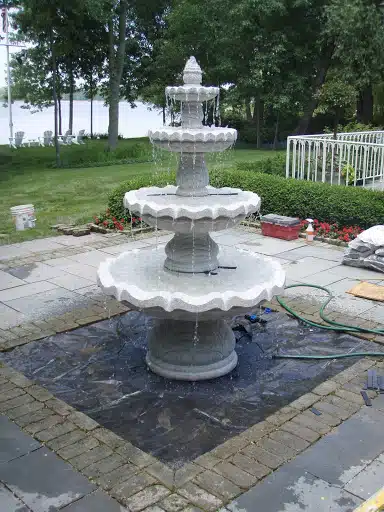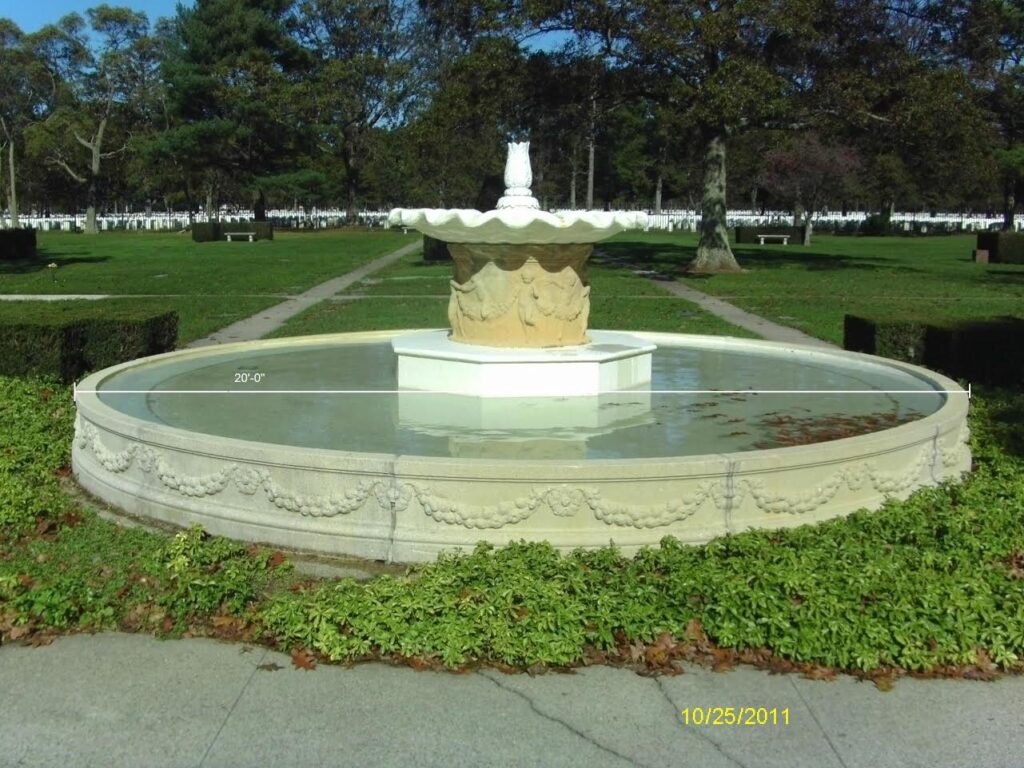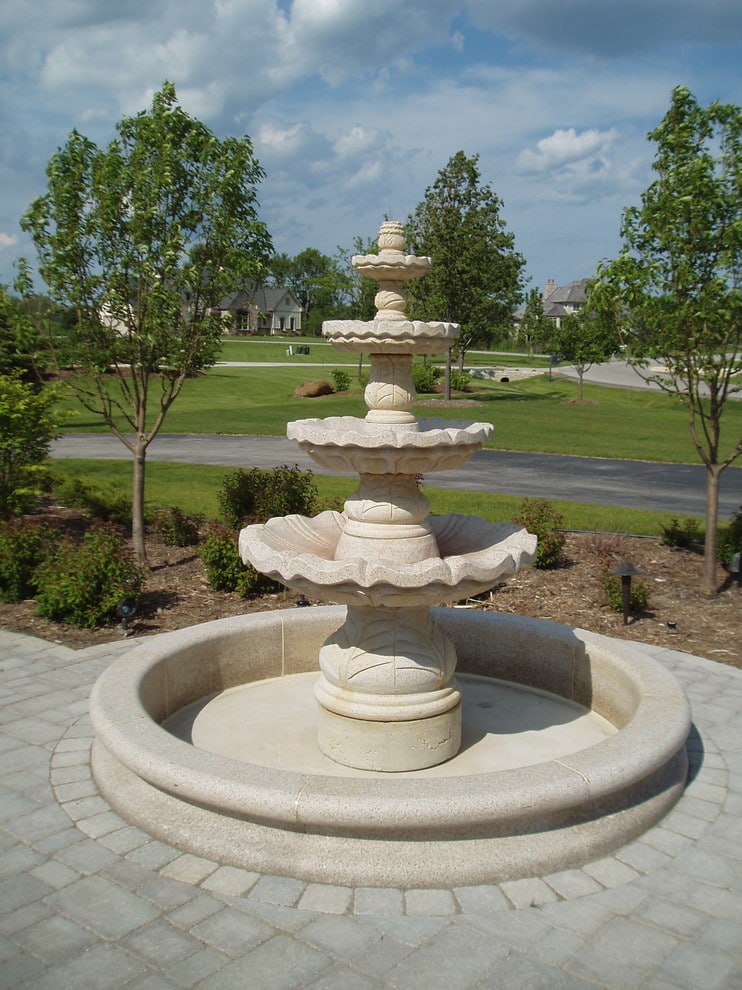
Natural stone water fountains are just one type of outdoor garden fountains or courtyard fountains, all of which add a striking and beautiful accent to your back yard or your patio, wherever you have it installed. After having made the commitment to installing one of these beautiful outdoor stone garden fountains, you certainly want to maintain it, so as to continue to derive the benefits of everything it brings to your outdoor setup, for a great many years. Below are listed some helpful guidelines you may want to use regarding the care and maintenance of your concrete garden fountain or your natural stone water fountain.
Treat the water in your fountain

Ideally, you should treat the water which circulates in your stone garden fountain once each week, with a solution that eliminates undesirable organisms, so as to prevent the proliferation of algae and to impede the buildup of minerals in the water. With the water being sanitized in this way, it will allow the fountain to function properly and will help to maintain its beautiful appearance. The exception to this tip would be if you have fish or any other kind of animals which are living in the water, and in that case, you would have to avoid chemical treatment and remove all algae in a manual fashion.
Ensure the water level is appropriate

With stone garden fountains, it’s important to make sure that they’re always filled up to an appropriate level with the water, and you can determine what this level is by checking the specifications made available to you at purchase time. If you no longer have the documentation for your fountain model, you should be able to find the information online. If your fountain operates with too little water in its reservoir, that can cause damage to the motor, and your fountain will probably need some major repairs at some point.
Avoid harsh abrasives

Natural stone can be classified into two general categories according to its composition: siliceous stone or calcareous stone. Knowing the difference is critical when selecting cleaning products.
Calcareous stone is composed mainly of calcium carbonate. It is sensitive to acidic cleaning products and frequently requires different cleaning procedures than siliceous stone. Types of calcareous stone include: marble, travertine, limestone, and onyx. What may work on siliceous stone may not be suitable on calcareous surfaces.
Don’t use vinegar, lemon juice, or other cleaners containing acids on marble, limestone, travertine, or onyx surfaces. Eventually, you will probably notice there’s a buildup of white scale around your fountain, and you can remove this fairly easily by simply using a non-abrasive cleaning agent, a soft sponge, and some water. It’s best not to use any heavy-duty cleaning chemicals unless you have an extreme case of white scale buildup because these kinds of chemicals can do serious damage to the finish of your fountain. Even the sponges you use for any cleanup should be very soft, so as to avoid scratching the surface, as you would with something like steel wool.
But, if you have a Granite Fountain (siliceous stone) – you won’t have to worry about stuff like that – since granite itself is so impermeable to chemical attack, there’s not a lot that could hurt it. (This is the same reason it’s such a good stone to use for fountains in climates that get ice or snow during winter, as the water can’t get inside the stone and cause the frost damage that tends to occur over time with those softer, more porous stones.) Therefore, if you get calcium or iron stains on granite, just using a 50/50 solution of muratic acid/water (for calcium scale) or ferrous acid / water (for iron stains) will melt the stain away like magic. (Before you start, making sure you protect your skin / eyes though – and do the cleaning on a non-windy day.) Then, you just rinse it liberally with water, and your stone will look brand new again!
Occasionally drain the fountain

Unless you have a very large fountain which contains several hundred gallons of water, it’s a good idea to drain your fountain completely at least once a month, so as to prevent the buildup of unwanted debris and materials inside pipes and inside your fountain’s pump. If you don’t occasionally drain the water, it can acquire a foul smell because the same water keeps circulating over and over again through the system, and it begins to take on an unpleasant odor. It might be a little bit of a hassle to do this, but it’s worth it in terms of retaining fresh-smelling, clear water circulating through your fountain. If you do own one of the larger models of outdoor fountains, you can treat the water to eliminate any sour or foul odors which might be emitted.
Clean components periodically
For smaller-sized fountains, it might be worth your while to clean your outdoor natural stone fountain about every three to four months, because that will contribute greatly to its long life. A ‘thorough’ cleaning means taking it apart completely, and cleaning off each one of its components so that all debris buildup is removed, and the piece is restored to close to its original condition. This will also give you the chance to inspect each of those components, to see if they are in need of repair or more extreme cleaning operations. By taking on this kind of cleaning on a regular basis, you can be pretty confident that there won’t be any sudden or unexplained breakdowns of your fountain, and that you can count on it to operate effectively for the foreseeable future. For much larger fountains, you can still clean the visible, external pieces, but you may need to call on professional help to have the internal components cleaned satisfactorily.
Don’t let pests reside in your fountain

All the things you’ve heard about mosquitoes and other varmints proliferating around areas which provide water are true – and they love to make a stone garden fountain their home if you allow that to happen. You can prevent pests from taking over your fountain by taking a few precautions which will discourage them from nesting anywhere around your outdoor fountain. Even though the water in your fountain is constantly circulating, there will be a few spots where the water is relatively calm, and these are the locations which mosquitoes and other critters will set up shop, and begin to proliferate. To eradicate mosquitoes and other pests, you can use an insecticide which is plant-friendly, and does no damage at all to any plants in your garden area, while still being brutal on mosquitoes.
Winterize your fountain
If you live in a geographic region which experiences frost, ice or snow during winter season, you should take steps to protect your fountain through that season, so it will be ready to go in the spring. The best way to approach this for very small fountains is to completely disassemble your stone fountain and place all pieces in an area which will be out of the weather, and ideally at room temperature, so as to avoid any possible cracking damage. Of course, all water would need to be drained from the fountain before taking it apart and drying off all the components. For larger/heavier fountains, you obviously can’t take them apart and place the components in a heated garage, but these models are fairly impervious to winter weather anyway, as long as they are carved of granite. If so, all you need to do is pull out the drain plugs from bowls, drain the pool, then clean the pump and then place it in a bucket of water in a heated storage space until fair weather returns.
If your fountain is rather made of a more porous stone like marble, limestone, travertine, onyx, cantera or concrete – then you have a lot more work to do – to protect your investment against freeze/thaw damage each Fall. Please work with the original manufacturer of your fountain on the actual winterization process, but it’ll invariably include things like covering the fountain so water cannot get to it, sealing it, etc. (That’s why we only recommend granite fountains to people in that kind of climate, as they are so easy to maintain, and you don’t have to worry about it falling apart from freeze/thaw damage.)

Keeping stone garden fountains functional and looking great
It doesn’t require a lot of work to maintain your outdoor natural stone fountain, and it basically only amounts to keeping the water clean and keeping components of the system clear of debris and undesirable materials. If you feel like you don’t have time to manage this kind of regular cleaning, you can definitely find a professional to manage it for you. However you choose to keep your stone garden fountain functioning at its best and looking its best, it will be well worth your while to do so, in order to continue enjoying your beautiful outdoor fountain for years to come.
